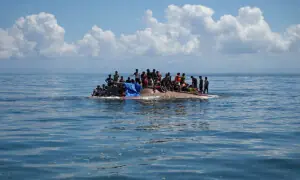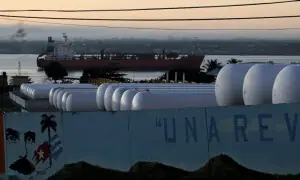Documents reveal multiple concerns raised over safety of Titan sub
Key points on submarine
- US coast guard says the source of underwater noise or banging has not been detected
- Magellan, an international exploration company that mapped the Titanic wreckage last year, will send underwater robots for the rescue mission. The robot will link the sub to the ship to be pulled out
- People in the sub have oxygen until 10.00 GMT (3pm) on Thursday
- The sub had many flaws and did not have any certification to be safe
- Three vessels participate in the search operation
The expedition that the Titan submersible and its crew were undergoing was tremendously risky, according to industry experts and former passengers.
The Titan had to withstand the pressure from being almost 4,000 metres (13,100ft) below sea level – the depth at which the Titanic came to rest – and faced the threat of getting lost or losing contact with the surface.
While it is too early to say what happened to the vessel, experts have raised questions over whether all appropriate safety measures were followed.
Stockton Rush, the chief executive and founder of OceanGate, creator of Titan, is among those missing. Rush has decades of engineering experience and has been at the helm of expeditions to the Titanic since 2021 – this was his fifth. OceanGate said there were a number of innovative safety features onboard the Titan.
The potential risks were made clear to passengers. Mike Reiss, who travelled on the Titan last year, told the BBC: “You sign a waiver before you get on that mentions death three different times. They’re learning as they go along … things go wrong. I’ve taken three different dives with this company and you almost always [lose] communication.”
Rear Adm John Mauger, of the US coast guard, said rescue efforts are prioritising both surface and sub-surface searches for the missing sub.
Mauger, speaking to BBC News, said: “This has been a very complex and difficult case for all of us but as we continue to actively search for the submersible and the people onboard our thoughts are with the crew members and their families who, I can imagine, are having a very difficult time at this point.”
“We have two vessels, two remote-operated vessels, a remote-operated vehicle conducting a sub-surface search, and we have an aircraft and surface vessels which are conducting the surface search at this moment.”
The crew of the submersible Titan may have less than 20 hours of breathable air remaining, if they are still alive, Mauger said.
It is hard to determine exactly how long they have, due to various factors, he said, adding the 20 hour estimate is based on an initial estimate that said the vessel had a 96-hour supply of oxygen.
The French ship Atalante, carrying a robot that can dive to 20,000ft (6,000 metres) underwater, is expected to arrive late today to join the search operation for the missing sub.
The unmanned robot, called Victor 6000, can dive deeper than other equipment now at the site in the North Atlantic and has arms that can be remotely controlled to cut cables or perform other manoeuvres to release a stuck vessel, Reuters reported, citing the robot’s operator, Ifremer.
Victor “is not capable of lifting the submarine on its own” but it can help hook the Titan sub to a ship with the capacity to lift it to the surface, Ifremer’s head of naval operations, Olivier Lefort, said.
Victor is able to do visual exploration with all the video equipment it has. It is also equipped with manipulating arms which could be used to extricate the sub, such as by sectioning cables or things that would be blocking it at the bottom.
He said the 25-strong crew required to operate the robot “can work non-stop for up to 72 hours” once it reaches the site. He added: We don’t know what happened. The noises that were heard give us hope the submarine is on the seabed and that people are still alive, but other scenarios are possible. Even if hope is slim, we’ll go all the way.
Rescuers continued to searched a vast swath of the North Atlantic for a fourth day on Wednesday, racing against time to find a missing tourist submersible that vanished while taking wealthy passengers on a voyage to the wreck of the Titanic in deep waters off Canada’s coast.
A Canadian rescue aircraft heard banging near the point when the submarine went missing on Wednesday.
The 21-foot-long Titan was built to stay underwater for 96 hours, according to its specifications - giving the five people aboard until Thursday morning before air runs out. One pilot and four passengers were inside the miniature sub early on Sunday when it lost communication with a parent ship on the surface about an hour and 45 minutes into its two-hour dive.
As Canadian and U.S. authorities stepped up the search, previous questions about the safety design and development of the submersible by its owner, U.S.-based OceanGate Expeditions, came to light.
The wreck of the Titanic, a British ocean liner that struck an iceberg and sank on its maiden voyage in April 1912, lies about 900 miles (1,450 km) east of Cape Cod, Massachusetts, and 400 miles (644 km) south of St. John’s, Newfoundland.
U.S. and Canadian aircraft have searched more than 7,600 square miles of open sea, an area larger than the state of Connecticut, U.S. Coast Guard Captain Jamie Frederick told reporters at a press conference on Tuesday.
The Canadian military has dropped sonar buoys to listen for any sounds that might come from the Titan, and a commercial vessel with a remote-controlled deepwater submersible was also searching near the site, Frederick said.
Separately, a French research ship carrying its own deep-sea diving robot vessel was dispatched to the search area at the request of the U.S. Navy and was expected to arrive Wednesday night local time, the Ifremer research institute said.
Those aboard Titan for a tourist expedition that costs $250,000 per person included British billionaire Hamish Harding, 58, and Pakistani-born businessman Shahzada Dawood, 48, with his 19-year-old son Suleman, who are both British citizens.
French explorer Paul-Henri Nargeolet, 77, and Stockton Rush, founder and CEO of OceanGate Expeditions, were also reported to be on board. Authorities have not confirmed the identity of any passenger.
Rescuers face significant obstacles both in finding the Titan and in saving the people aboard, according to experts.
If the submersible experienced a mid-dive emergency, the pilot would likely have released weights to float back to the surface, according to Alistair Greig, a marine engineering professor at University College London. But absent communication, locating a van-sized submersible in the vast Atlantic could prove challenging, he said.
The submersible is sealed with bolts from the outside, preventing the occupants from escaping without assistance even if it surfaces.
If the Titan is on the ocean floor, a rescue effort would be even more challenging due to the extreme conditions more than 2 miles beneath the surface. The Titanic lies 12,500 feet (3,810 meters) underwater, where no sunlight penetrates. Only specialized equipment can reach such depths without being crushed by the massive water pressure.
“It’s really a bit like being an astronaut going into space,” said Tim Matlin, a Titanic expert. “I think if it’s on the seabed, there are so few submarines that are capable of going that deep. And so, therefore, I think it was going to be almost impossible to effect a sub-to-sub rescue.”
Safety issues raised before
The ability of the tourist sub’s hull design to withstand such depths was questioned in a 2018 lawsuit filed by OceanGate’s former director of marine operations, David Lochridge, who said he was fired after he raised safety concerns about the vessel.
OceanGate said in its breach-of-contract suit against Lochridge, who is not an engineer, that he refused to accept the lead engineer’s assurances and accused him of improperly sharing confidential information. The two sides settled their court case in November 2018.
The company did not respond to requests for comment from Reuters and its attorney in the Lochridge case, Thomas Gilman, declined comment. An attorney for Lochridge declined comment except to say, “We pray for everyone’s safe return.”
Months prior to the suit, a group of submersible industry leaders wrote to OceanGate warning that the “experimental” approach“ to the sub’s development could result in “minor to catastrophic” problems, the New York Times reported.
U.S. President Joe Biden was “watching events closely,” White House national security adviser John Kirby said on Tuesday. Britain’s King Charles asked to be kept apprised of the search, a Buckingham Palace source said, as Dawood is a longtime supporter of the monarch’s charity, the Prince’s Trust International.
OceanGate said it was “mobilizing all options,” and U.S. Coast Guard Rear Admiral John Mauger told NBC News the company was helping to guide the search efforts.
“They know that site better than anybody else,” Mauger said. “We’re working very closely with them to prioritize our underwater search efforts and get equipment there.”
Billionaire aboard
OceanGate schedules five week-long “missions” to the Titanic each summer, according to its website.
David Pogue, a CBS reporter, rode aboard the Titan last year. In a December news report, he read aloud the waiver he had to sign, which noted the submersible had “not been approved or certified by any regulatory body” and could result in death.
In an interview on Tuesday, Pogue said OceanGate has successfully ventured to the wreck around two dozen times and that the company conducts a meticulous safety check before each dive.
“They treat this thing like a space launch,” he said.
Harding, a UAE-based businessman and adventurer who is chairman of Action Aviation, posted a message on Facebook on Saturday, saying: “This mission is likely to be the first and only manned mission to the Titanic in 2023.”
Fellow tourist Dawood is vice chairman of Engro, one of Pakistan’s largest conglomerates.
The sinking of the Titanic, which killed more than 1,500 people, has been immortalized in books and films, including the 1997 blockbuster movie “Titanic,” which renewed popular interest in the wreck.
For the latest news, follow us on Twitter @Aaj_Urdu. We are also on Facebook, Instagram and YouTube.




















Comments are closed on this story.